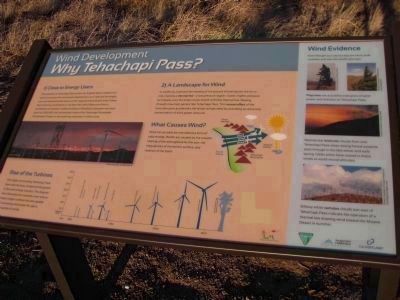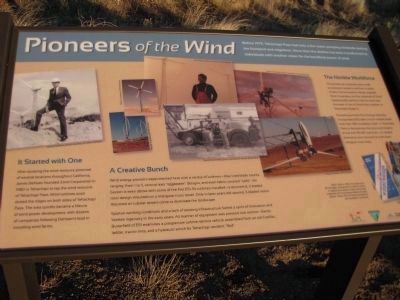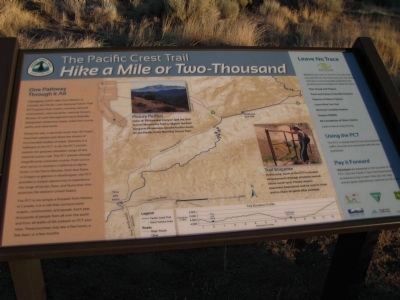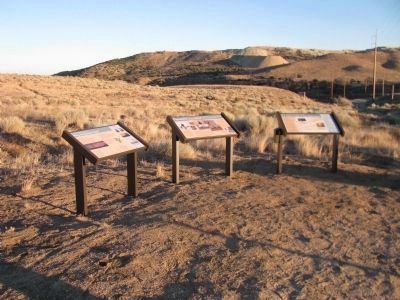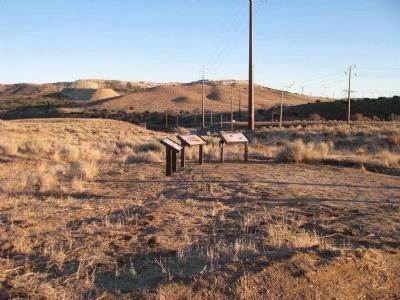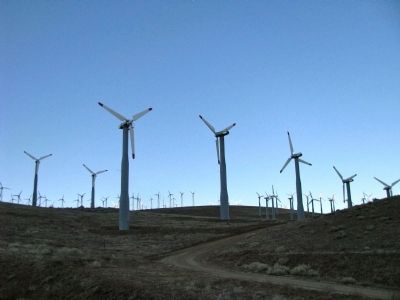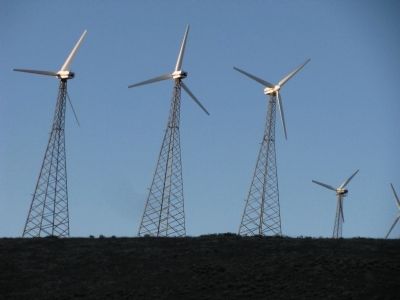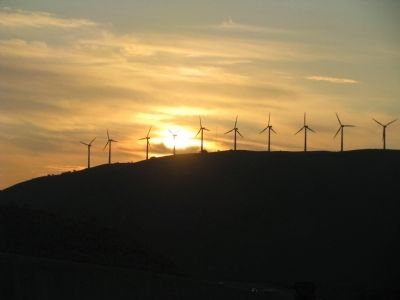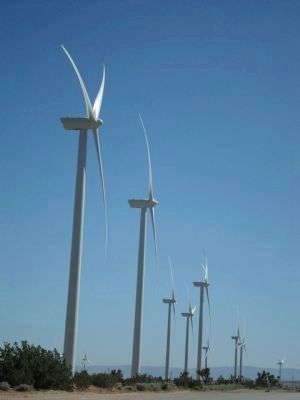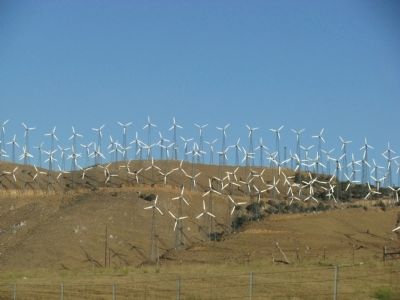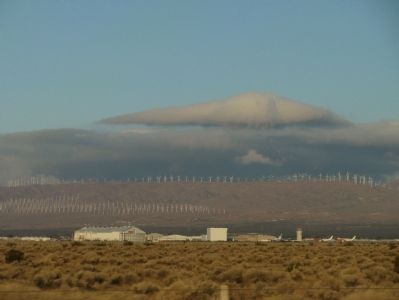Tehachapi in Kern County, California — The American West (Pacific Coastal)
Why Tehachapi Pass? / Pioneers of the Wind / Hike A Mile or Two - Thousand
First Panel:
Wind Development
Why Tehachapi Pass?
1) Close to Energy Users
The proximity of Tehachapi Pass to the Los Angeles Basin makes it an attractive location for wind power development, as it reduces the length, cost, and environmental impact of the required transmission lines. Power from numerous wind farms in the East Kern Wind Resource Area is conditioned at Southern California Edisonís Windhub substation and sent south on 500,000 Volt transmission lines of the Tehachapi Renewable Transmission Project to the receiving substation in Mira Loma.
Rise of the Turbines
The ridges surrounding Tehachapi Pass have told the story of exponential growth in the wind energy industry. The diagram here illustrates the transition over time to todayís larger turbines that are capable of converting wind power for use in thousands of homes.
2) A Landscape for Wind
In California, summertime heating of the ground inland causes the air to rise, creating a thermal low- a low pressure region. Cooler, higher-pressure air masses over the ocean move inland to fill the thermal low, flowing through mountain passes like Tehachapi Pass. This venturi effect of the mountain pass accelerates the winds to high velocity, providing an attractive concentration of wind power resource.
What Causes Wind?
Wind can actually be considered a form of solar energy. Winds are caused by the uneven heating of the atmosphere by the sun, the irregularities of the earthís surface, and rotation of the Earth.
Second Panel:
Pioneers of the Wind
Before 1979, Tehachapi Pass had only a few water-pumping windmills dotting the farmland and ridgelines. Since then the skyline has been transformed by individuals with another vision for the beneficial power of wind.
It Started with One
After studying the wind-resource potential of several locations throughout California, James Dehisen founded Zond Corporation in 1980 in Tehachapi to tap the wind resource of Tehachapi Pass. Wind turbines soon dotted the ridges on both sides of Tehachapi Pass. The area quickly became a Mecca of wind power development, with dozens of companies following Dehlsenís lead in installing wind farms.
A Creative Bunch
Wind energy pioneers experimented here with a variety of turbines-they tried blade counts ranging from 1 to 5, vertical-axis “eggbeater” designs, and even fabric-covered “sails”. Jim Sexton is seen above with some of the first ESI-54 turbines installed-a downwind, 2-bladed rotor design mounted on a triangular truss tower. Only in later years did upwind, 3-bladed rotors mounted on tubular towers come to dominate the landscape.
Spartan working conditions and a lack of existing infrastructure fueled a spirit of innovation and Yankee ingenuity in the early years. All manner of equipment was pressed into service-Sandy Butterfield of ESI examines a prospective turbine-service vehicles assembled from an old Cadillac, ladder, tractor tires, and a hydraulic winch by Tehachapi resident “Red”.
The Nimble Workforce
The pioneering companies were small, so everyone needed to perform a variety of jobs. Control-systems design engineer Kevin Cousineau, the first employee of Zond Systems (left), performs service work atop the tower of one of Zondís first turbines-a Stormaster Model 12.
Pioneering workers from Energy Sciences, Incorporated (ESI) take a much-needed break from their 1984 installation work in Tehachapi Pass to demonstrate the structural integrity of one their ESI-80 machines-a 2-bladed downwind rotor mounted on a tilt-down triangular truss tower.
Third Panel:
The Pacific Crest Trail
Hike a Mile or Two-Thousand
One Pathway Through it All
Zigzagging 2,650 miles from Mexico to Canada, the Pacific Crest National Scenic Trail (PCT) spans three states, crossing national monuments, national parks, national forests, Bureau of Land Management land, federally designated wilderness areas, state and country parks, and tribal lands.
Along the way, it ascends more than 50 major mountain passes and skirts the shores of innumerable bodies of water. Diversity is a hallmark of the PCT. In all, the PCT encompasses the greatest elevation range of any national scenic trail. The PCT passes through magnificently untamed country. From yucca and cactus in southern California to alpine lichen in the Sierra Nevada; from the lava flows in Oregon to glaciers in Washington; the PCT provides a unique opportunity to experience the range of terrain, flora, and fauna that characterizes the western United States.
The PCT is not simply a footpath from Mexico to Canada; it is a trail that connects landscapes, communities, and people. Each year thousands of people from all over the world and from all walks of life embark on PCT journeys. These journeys may last a few hours, a few days, or a few months.
Leave No Trace
Whether you trek on the PCT is a day hike or you are here for the long haul, you and others will have a more enjoyable experience by practicing the principles of Leave Not Trace.
Plan Ahead and Prepare
Travel and Camp on Durable Surfaces
Dispose of Waster Properly
Leave What You Find
Minimize Campfire Impacts
Respect Wildlife
Be
Considerate of Other Visitors
Learn more at www.int.org
Using the PCT
The PCT is designed for foot and equestrian traffic; bicycles and motorized vehicles are prohibited.
Pay it Forward
Volunteers are essential to the success of the PCT. Visit the Pacific Crest Trail association at www.pcta.org to learn how you can help ensure great experiences continue on the trail.
Erected 2012 by Pacific Crest Trail Foundation, Tehachapi Wind Museum, The Bakersfield California Foundation, CALPORTLAND.
Topics. This historical marker is listed in these topic lists: Environment • Notable Places.
Location. 35° 3.151′ N, 118° 21.457′ W. Marker is in Tehachapi, California, in Kern County. Marker is on Cameron Canyon Road, on the right when traveling east. It is located just off Cameron Cayon Road and Tehachapi Willow Springs Road. Touch for map. Marker is in this post office area: Tehachapi CA 93561, United States of America. Touch for directions.
Other nearby markers. At least 8 other markers are within 8 miles of this marker, measured as the crow flies. Oak Creek Pass (approx. 1.9 miles away); Mountain Valley Airport (approx. 5 miles away); Tehachapi Eastside Cemetery War Memorial (approx. 6.4 miles away); Avelino Martinez (approx. 6Ĺ miles away); Tomo-Kahni
(approx. 6.9 miles away); T-Hacha-P Brand Mural (approx. 7.3 miles away); First Methodist & Episcopal Church (approx. 7.3 miles away); August Weferling House (approx. 7.4 miles away). Touch for a list and map of all markers in Tehachapi.
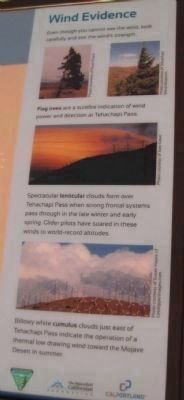
Photographed By Denise Boose, January 8, 2013
12. Close-Up of Side Panel 1
Even though you cannot see the wind, look carefully and see the wind's strength.
Flag Tree are a surefire indication of wind power and direction at Tehachapi Pass.
Spectacular lenticular clouds form over Tehachapi Pass when strong frontal systems pass through in the late winter and early spring. Glider pilots have soared in these winds to world-record altitudes.
Billowy white cumulus clouds just east of Tehachapi Pass indicated the operation of a thermal low drawing wind toward the Mojave Desrt in summer.
Credits. This page was last revised on August 1, 2018. It was originally submitted on February 9, 2013, by Denise Boose of Tehachapi, California. This page has been viewed 1,168 times since then and 110 times this year. Photos: 1, 2, 3, 4, 5, 6, 7, 8, 9, 10, 11, 12. submitted on February 9, 2013, by Denise Boose of Tehachapi, California. • Syd Whittle was the editor who published this page.
